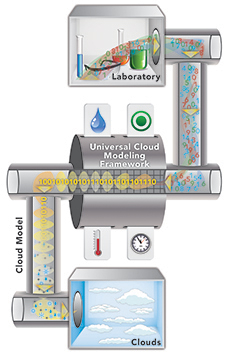Atmospheric Sciences & Global Change Division
Research Highlights
September 2012
Dust Achieves Lofty Aspirations
Disposition to form ice crystals is measured and modeled for a new-fangled framework

This conceptual model illustrates the path PNNL researchers used to steer multiple data points into one flexible calculation, efficiently simulating how ice forms on dust particles and produces clouds. This universal calculation will help them describe how ice crystals are formed on other particles, such as atmospheric soot, organic, and biological particles. Enlarge Image
Results: Instead of dust-bunnies under the sofa, this dust helps form ice crystals that are at the heart of clouds. Researchers at Pacific Northwest National Laboratory used dust’s loftier disposition to create a new way to calculate how all particles, not just dust, attract and form ice crystals in clouds. Steering multiple data points into one flexible calculation, they efficiently simulated how ice forms on dust particles, a calculation that will help them nail down how ice latches on to atmospheric soot, organic, and biological particles as well. Their research was published in the August issue of Atmospheric Chemistry and Physics.
Why It Matters: The U.S. and other parts of the world are suffering record drought this year. Looking at the genesis of rain and snow, and how the Earth warms and cools are crucial to daily life. Tiny ice crystals in the clouds can be instigators of rain and snow. Ice crystals can reflect and scatter sunlight away from the Earth, cooling the surface. Thus, ice crystals are tiny provocateurs for both precipitation and Earth’s warming and cooling. Scientists in this study are tracking down the very basics of how ice forms in the atmosphere, beginning with its attraction to dust – one of several ways that ice crystals form. Their finding of a universal calculation for how this happens will enable them to model and predict other ways that ice crystals are formed.
Methods: Previously, scientists had to rely on individual data points to represent the process of ice forming on dust particles. In this study, PNNL researchers developed a new way to translate multiple observation data points into one efficient parameterization framework used in cloud and climate models. Parameterizations are calculations that allow scientists to represent field or laboratory observations in computer simulations. This framework not only works on dust particles shown in this study, it can be used with many different data sets.
The framework takes into account a standard way to measure how efficiently ice forms on a substance and calculated the probability that a seed particle—in this case dust—will form an ice crystal. The higher the contact angle, the more resistance the particle has to forming ice. Their new framework is a model representation that packs more information about the ice forming properties into one formulation than previous frameworks.
The team confirmed that the new framework well-represented observations and they showed that cloud properties are highly sensitive to particle contact angle. Cloud formation is delayed with the increased contact angle of the nucleating particles. Using the new framework approach, they reliably compared one data set to another.
What's Next? To further simplify the calculation task in a cloud model, the researchers will continue to extend the process to different types of dust and atmospheric particles at a range of temperatures. They will implement the framework in the global climate model to investigate the climate impacts.
Acknowledgments: This work was supported by PNNL’s Laboratory Directed Research and Development program through the Aerosol Climate Initiative and was performed by Drs. Gourihar Kulkarni, Jiwen Fan, Jennifer M. Comstock, Xiaohong Liu and Mikhail Ovchinnikov at PNNL.
Reference: Kulkarni G, J Fan, JM Comstock, X Liu and M Ovchinnikov. 2012. “Laboratory Measurements and Model Sensitivity Studies of Dust Deposition Ice Nucleation.” Atmospheric Chemistry and Physics Discussions 12(1):2483-2516. DOI:10.5194/acp-12-7295-2012.
